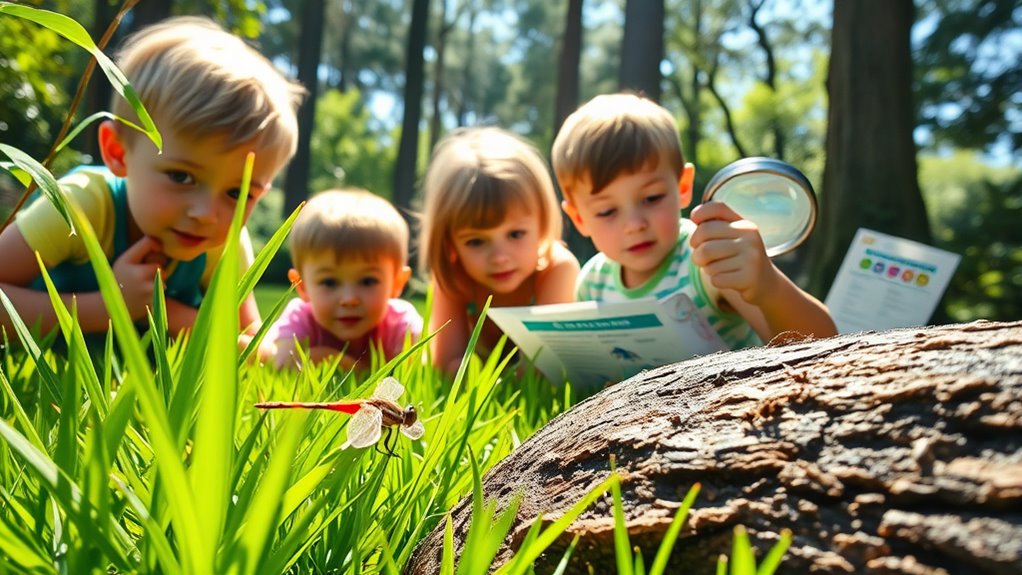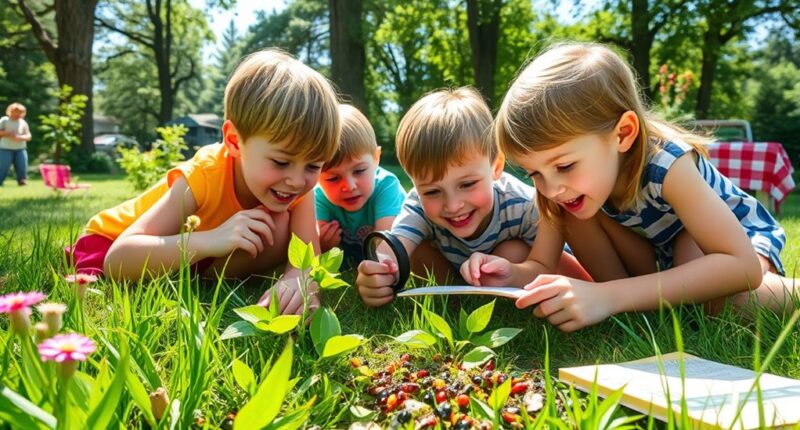Transform your backyard into an exciting natural classroom by organizing scavenger hunts and bug safaris. Use checklists to find items like leaves, feathers, or flowers, while gently collecting insects with jars or nets. These activities boost observation skills and foster curiosity about plants and wildlife. With simple tools and a little guidance, you can turn ordinary outdoor moments into educational adventures. Keep exploring, and you’ll uncover even more ways to make nature a fun discovery zone.
Key Takeaways
- Use checklists for scavenger hunts to encourage active searching for natural items like leaves, feathers, and flowers.
- Collect insects with jars or nets to observe critters safely and respectfully during bug safaris.
- Incorporate educational guides or apps to identify plants and wildlife discovered during outdoor explorations.
- Capture photographs of insects, birds, and sunlight to enhance observation skills and document local ecosystems.
- Transform backyard walks into mini adventures by turning ordinary moments into opportunities for discovery and learning.

Have you ever wondered what it’s like to step into the wild and truly connect with nature? It’s a feeling that awakens your senses and sparks your curiosity. You don’t need to go far to experience this—your backyard can be a treasure trove of discovery. Whether you’re on a scavenger hunt or a bug safari, you’ll find endless opportunities to learn and explore. One of the best ways to deepen your outdoor experience is through plant identification. As you walk around, start noticing the different shapes, colors, and textures of leaves, flowers, and trees. Use a plant identification app or a field guide to help you recognize various species. This activity transforms a simple walk into a mini adventure and sharpens your observational skills. Plus, it’s incredibly satisfying to put a name to a plant you’ve never noticed before. If you’re into photography, wildlife photography can be a rewarding part of your exploration. Capture the tiny insects crawling on leaves, birds perched in trees, or even the way sunlight filters through branches. Your backyard is full of hidden life just waiting to be documented. By taking photos, you not only preserve memories but also enhance your understanding of local ecosystems. As you focus on wildlife photography, you develop a keener eye for detail, learning to spot subtle movements and behaviors that often go unnoticed. Incorporating high-quality equipment like a good camera or macro lens can significantly improve your photos and make your discoveries more vivid. Engaging in a scavenger hunt adds a fun, goal-oriented twist to your outdoor time. Make a list of common backyard items—such as a feather, a unique leaf, or a specific flower—and see how many you can find. It keeps you actively searching and paying close attention to your surroundings. For a more immersive experience, try a bug safari. Bring a jar or a net and gently collect insects like beetles, caterpillars, or grasshoppers. Observe their features up close and see how they move or interact with their environment. This hands-on approach makes learning about insects more tangible and fascinating. Just remember to be gentle and respectful, leaving critters where you found them once you’ve finished observing. Combining these activities makes your backyard a lively classroom, where you can practice plant identification, perfect your wildlife photography, and enjoy a sense of adventure without leaving home. Exploring nature in your own space encourages a deeper appreciation for the natural world and helps you develop skills that can accompany you on future outdoor adventures. It’s a simple, rewarding way to stay connected with nature daily, turning ordinary moments into extraordinary discoveries.
Frequently Asked Questions
What Safety Tips Should I Follow During Backyard Explorations?
When exploring your backyard, safety tips help keep everyone secure. Always wear safety gear like gloves and bug spray to protect yourself. Supervision tips are essential; adults should stay nearby to monitor kids and handle emergencies. Teach children to avoid touching unknown plants or insects. Keep a first aid kit handy, and make sure everyone knows basic safety rules. Following these tips guarantees your backyard adventures are fun and safe for everyone involved.
Are There Any Age Restrictions for Bug Safaris?
Age restrictions for bug safaris? Who knew insects would be so exclusive! Don’t worry, safety guidelines are your best friends here. Usually, younger kids need supervision to prevent mishaps, while older adventurers can explore more freely. It’s all about making sure everyone’s safe and having fun. So, check the activity’s age restrictions beforehand—after all, even bugs have their own club rules!
How Can I Identify Different Insects and Plants?
To identify different insects and plants, start by observing their size, color, and patterns. Use identification techniques like field guides or mobile apps to compare features. For plant recognition, focus on leaf shape, flower structure, and bark texture. Take clear photos, note the environment, and consult resources or experts online. With patience and practice, you’ll become better at distinguishing various insects and plants in your backyard.
What Equipment Is Necessary for a Successful Scavenger Hunt?
Think of it as your toolkit for adventure. You’ll need some equipment essentials like a small notebook, a pencil for jotting down clues, and a magnifying glass to examine tiny wonders. Scavenger hunt tools such as a camera or smartphone help capture your discoveries. Comfortable shoes and a sense of curiosity complete your gear, making each hunt exciting and successful. With these supplies, you’re ready to uncover nature’s secrets right in your backyard.
How Can I Make These Activities Environmentally Friendly?
To make these activities eco-friendly, you should use sustainable practices and eco-friendly materials. Opt for reusable containers and avoid single-use plastics to reduce waste. Encourage participants to respect wildlife by observing quietly and not disturbing habitats. Teach kids about conservation and leave no trace by cleaning up thoroughly afterward. Incorporating these sustainable practices guarantees your outdoor adventures are fun and environmentally responsible, helping preserve nature for future generations.
Conclusion
As you wrap up your backyard adventure, remember that over 80% of land insects are beneficial to ecosystems. Your scavenger hunts and bug safaris not only reveal nature’s hidden treasures but also support local biodiversity. By taking the time to explore, you’re helping foster a deeper appreciation for the environment right outside your door. So keep exploring, observing, and learning—nature’s wonders are waiting just beyond your backyard!









